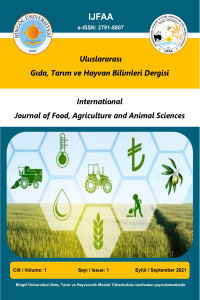Bal Arılarının Önemli Virusları
Virusların nesillerini devam ettirebilmeleri için özgün reseptörlerini taşıyan hücrelerde mutlaka çoğalmaları gerekir. Virusların hedefi olan bu işlevsel hücrelerde üreme sonucunda değişiklikler meydana gelir. Bu değişiklikler, virusla karşılaşan hücrenin parçalanması sonucu hücrenin ölmesi, hücrenin hayatta kalması ancak virusun sürekli saçılması, hücrenin genetik yapısındaki değişiklik ile sürekli çoğalmasıdır. Bal arılarında, deforme kanat virusu, arı gelişim döneminde kanat oluşum hücrelerinde çoğaldığında, bu hücreler üzerindeki öldürücü etkilerinden dolayı ergin arıda kanatların deformasyonuna neden olur. Virusun bu deformasyonu ile bal arılarının kanatları oluşmaz, arılar uçamazlar, beslenemezler ve ölürler. Bu derlemenin amacı, bal arılarında etkisi olan özgün virusların, arılara bulaşma yolları ve bal arısı kolonileri üzerindeki etkilerine vurgu yapmaktır.
Anahtar Kelimeler:
Bal Arısı, Önemli Virüsler, Hastalıklar.
Important Viruses of Honey Bees
In order for viruses to continue their generation, they must necessarily replicate in cells carrying their receptors. Changes occur in these unique cells, which are the target of viruses, as a result of result of reproduction. These changes are the death of the cell as a result of the disintegration of the cell that encounters the virus, the survival of the cell, but the constant scattering of the virus, the change in the genetic structure of the cell, the continuous reproduction of the cell, and the hiding of the virus in the cell. When the deformed wing virus replicates in the wing formation cells during the bee development period, it causes deformation of the wings in the adult bee due to its effects on these cells. Because bees with deformed wings cannot fly, they cannot feed and die. The aim of this review is to emphasize the viruses specific to bees, their transmission routes to bees and their effects on honey bee colonies.
Keywords:
Honey Bee, Important Viruses, Diseases,
___
- Anonymus, 2022a. Virus Taxonomy: The ICTV Report on Virus Classification and Taxon Nomenclature. https://ictv.global/taxonomy. Erişim 07.09.2022.
- Anonymus, 2022b. Wikipedia, https://en.wikipedia.org/wiki/Main_Page. Erişim, 25.09.2022.
- Anonymus, 2022c. Flickr. https://www.flickr.com/photos/absolutefolly/8856545015, Erişim, 25.09.2022.
- Anonymus, 2022d. National Benptyping Center, USA,https://www.genotypingcenter.com/. Erişim, 25.09.2022.
- Anonymus, 2022e. Scientific Beekeeping, https://www.scientificbeekeeping.co.uk/ABPV.html, Erişim, 25.09.2022.
- Anonymus 2022f. Pembrokeshire Beekeper’s Association, https://pbka.info/2014/05/01/bee-health-monthly-sacbrood/. Erişim, 25.09.2022.
- Anonymus 2022g. Somerset Beekeper’s Association, https://www.somersetbeekeepers.org.uk/, Erişim, 25.09.2022.
- Ball, B.V. 1983. The association of Varroa jacobsoni with virus diseases of hony bees. Exp. Appl. Acarol. (19) 607-613.
- Britton, N. F., Jane White, K. A. 2021. The effect of covert and overt infections on disease dynamics in honey-bee colonies. Bulletin of Mathematical Biology, 83 (6), 1-23.
- Cengiz, M. (2012). In honey bee colonies (Apis mellifera L.), usage of different organics compounds and their effects to colony performance against Varroa destructor infestation. Kafkas Universitesi Veteriner Fakultesi Dergisi, 18 (Suppl-A): A133-A137.
- Chen, Y., Evans, J., Feldlaufer, M. 2006. Horizontal and vertical transmission of viruses in the honey bee, Apis mellifera. Journal of invertebrate pathology, 92(3), 152-159.
- Chen YP, Pettis JS, Corona M, Chen WP, Li CJ, Spivak M, Visscher PK, DeGrandiHoffman G, Boncristiani H, Zhao Y, vanEngelsdorp D, Delaplane K, Solter L, Drummond F, Kramer M, Lipkin WI, Palacios G, Hamilton MC, Smith B, Huang SK, Zheng HQ, Li JL, Zhang X, Zhou AF, Wu LY, Zhou JZ, Lee ML, Teixeira EW, Li ZG, Evans JD. 2014. Israeli acute paralysis virus: epidemiology, pathogenesis and implications for honey bee health. PLoS Pathog; 10:e1004261.
- DeGrandi-Hoffman, G., Chen, Y., Simonds, R. 2013. The effects of pesticides on queen rearing and virus titers in honey bees (Apis mellifera L.). Insects, 4(1), 71-89.
- Genersch, E., Aubert, M. 2010. Emerging and re-emerging viruses of the honey bee (Apis mellifera L.). Veterinary research, 41 (6), 54.
- Goulson, D., Nicholls, E., Botias,C. Rotheray, E.L. 2015. Bee declines driven by combined stress from parasites pesticites and lack of flowers. Science 347 (6229) 1255957.
- Govan, V. A., N. Leat, M. Allsop, S. Davison 2000. Analysis of the complete genome sequence of acute bee paralysis virus shows that it belongs to the novel group of insect-infecting RNA viruses. Virology, 277:457-463.
- Gürçay, M. (2019). Uluslararası Arıcılık Araştırmaları ve Sürdürülebilir Kırsal Kalkınma Stratejileri Kongresi (Arı-SKKS2019) 11-13 Ekim 2019, Bingöl, Türkiye.
- Nordstrom, S., I. Fries, A. Aarhus, H. Hansen, and S. Korpela. 1999. Virus infections in Nordic honey bee colonies with no, low or severe Varroa jacobsoni infestation. Apidologie 30: 457-466.
- O’Shea-Wheller, T. A., Rinkevich, F. D., Danka, R. G., Simone-Finstrom, M., Tokarz, P. G.,Healy, K. B. 2022. A derived honey bee stock confers resistance to Varroa destructor and associated viral transmission. Scientific reports, 12(1), 1-19.
- Ünal, H.H. (2010), Research of honey bee colony losses and deaths in Marmara region. 4th EurBee Congress Book, p. 64, 7-9th September 2010, Ankara, Turkey.
- Ramsey, Samuel D.; Ochoa, Ronald; Bauchan, Gary; Gulbronson, Connor; Mowery, Joseph D.; Cohen, Allen; Lim, David; Joklik, Judith; Cicero, Joseph M.; Ellis, James D.; Hawthorne, David; vanEngelsdorp, Dennis 2019. "Varroa destructor feeds primarily on honey bee fat body tissue and not hemolymph". Proceedings of the National Academy of Sciences. 116 (5): 1792–1801.
- Spurny, R., Přidal, A., Pálková, L., Kiem, H. K. T., de Miranda, J. R., Plevka, P. 2017. Virion structure of black queen cell virus, a common honeybee pathogen. Journal of virology, 91(6), e02100-16.
- Yeşilbağ, K., 2021. Veteriner Viroloji. Hayvanların Viral hastalıkları. Medipres Yayınevi. Malatya.
- Başlangıç: 2021
- Yayıncı: Bingöl Üniversitesi
Sayıdaki Diğer Makaleler
Asplenium L. Cinsinin Ekolojisi ve Korolojisi İle İlgili Bir Çalışma
Gönül KAYNAK, Özer YILMAZ, Mihriban AHISKALI
Kurak Mevsim Takviyesi Olarak Gofretin Yarı Kurak, Nijerya'da Uda Koyun Performansına Etkileri
H. B. MOHAMMED, İbrahim El İMAM, I. R. MUHAMMAD, M. BABA
Balın Geleneksel Kullanımı, Terapötik Özellikleri ve Antioksidan Aktivitesi
Ibrahim ELİMAM, Hind SALİH, I. BUSHARA
Bal Arılarının Önemli Virusları
Metin GÜRÇAY, Mehmet Ali KUTLU
Tam Ranklı Olmayan Modellerin Çözümü: Bingöl’de Erik Üretimi Üzerine Bir Uygulama
